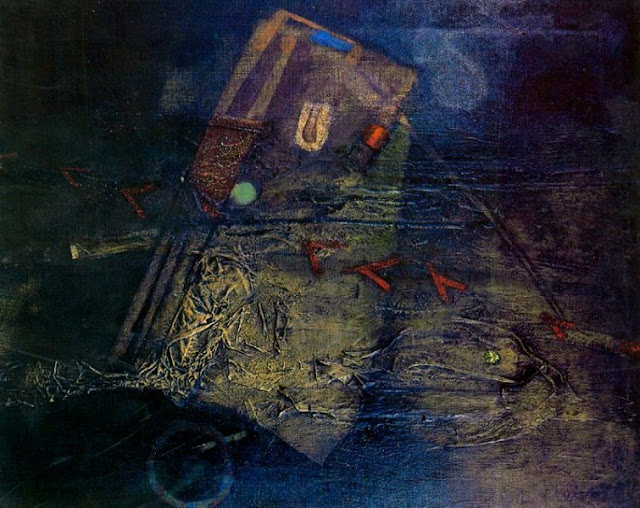"The Catalan artist Modest Cuixart, who has died aged 81 after a fall, was a leading figure in the post-civil war art movement in Spain that challenged the Franco dictatorship and reignited artistic creativity after the stagnation of the war years. Cuixart was one of those who fought to free themselves, not only from Franco's oppression and censorship, but from his heavy-handed attempt to bring the nation's artists under his wing.Unlike many of his fellow artists, Cuixart never went into permanent exile in Franco's time but, after the dictator sought to exploit his popularity by calling him "our contemporary Goya", he spent much of his time in France, chiefly Paris and Lyon. Unlike Picasso, he refused to have his works exhibited by Franco's government in the Spanish pavilion at the World's Fair in New York in 1964. "We were the opposition, we were the left, we were anarchists," he said many years later.
Cuixart, who was known early in his career by the Spanish forename Modesto, rather than the Catalan Modest (in line with Franco's ban on public use of the Catalan or Basque languages), became a driving force behind the Spanish modern art movement of the latter half of the 20th century. Along with his cousin, Antoni Tàpies, he used his paintings to express what could not be articulated during Franco's strongest years. By the early 1960s, Cuixart's abstract works were being exhibited in galleries worldwide, from the Guggenheim in New York to the Tate in London.
In 1948, together with Tàpies and poet Joan Brossa, Cuixart co-founded the Dau al Set group - Catalan painters and poets who criticised the dictatorship through surreal paintings and writings and became the vanguard of Spain's drive to get out of its artistic and spiritual stagnation. The group was initially influenced by surrealism and dadaism, by Max Ernst and Paul Klee, not least by fellow Catalans Joan Miró and Salvador Dalí. By 1956, when Dau al Set members went their separate ways, Cuixart had become a leading exponent of the informalist school and later of abstract painting. To give "grit" to his paintings, he used, literally, grit, or sand, straw, cloth or whatever he felt appropriate, to add texture to his canvasses. He once said textures conveyed the feel of the civil war and its aftermath, a feel that lingers not only in his art but in present-day Spanish life, despite the return to democracy. New baroque was how he described his work during Franco's regime. By the early 1960s, he was working with collage and producing the type of works which would soon become described as pop-art.
Advertisement
Advertisement
Cuixart was born in Barcelona. Although he loved drawing as a child, he studied medicine in 1944 until the after-effects of the civil war drove him in 1947 to abandon his desire to become a doctor and to take up art full time, initially influenced by the expressionists. Soon afterwards, along with Tàpies, he met Miró in Paris, and later, in the same city, Picasso, who, though born in Andalucia, had studied art in Barcelona.
In 1959, Cuixart gained international recognition when he won the prize for best painter at the São Paolo Bienal in Brazil. Among other shortlisted contestants was Francis Bacon, while Barbara Hepworth won the grand prize for her sculptures. After the awards, Time magazine wrote: "Cuixart makes elegant mud pies, the blackest and heaviest in the notably gloomy Spanish exposition. Black may always be in fashion, especially in Spain. Yet the spirit of Goya is clearly not with Cuixart. He makes despair chic."
In 1959, Cuixart gained international recognition when he won the prize for best painter at the São Paolo Bienal in Brazil. Among other shortlisted contestants was Francis Bacon, while Barbara Hepworth won the grand prize for her sculptures. After the awards, Time magazine wrote: "Cuixart makes elegant mud pies, the blackest and heaviest in the notably gloomy Spanish exposition. Black may always be in fashion, especially in Spain. Yet the spirit of Goya is clearly not with Cuixart. He makes despair chic."
From the early 1970s, Cuixart made his home in the town of Palafrugell, near Palamós in the Catalan province of Girona. Since 1998, the town has been the site of the Cuixart foundation, a museum in his honour. Until shortly before his death, Cuixart, who gave up painting in 2002, could regularly be seen drinking and exchanging ideas with artists and tourists in the Can Moni restaurant and bar in Palamós.
Modest Cuixart, artist, born November 2 1925; died October 31 2007"(www.theguardian.com)
Modest Cuixart, artist, born November 2 1925; died October 31 2007"(www.theguardian.com)











No comments:
Post a Comment